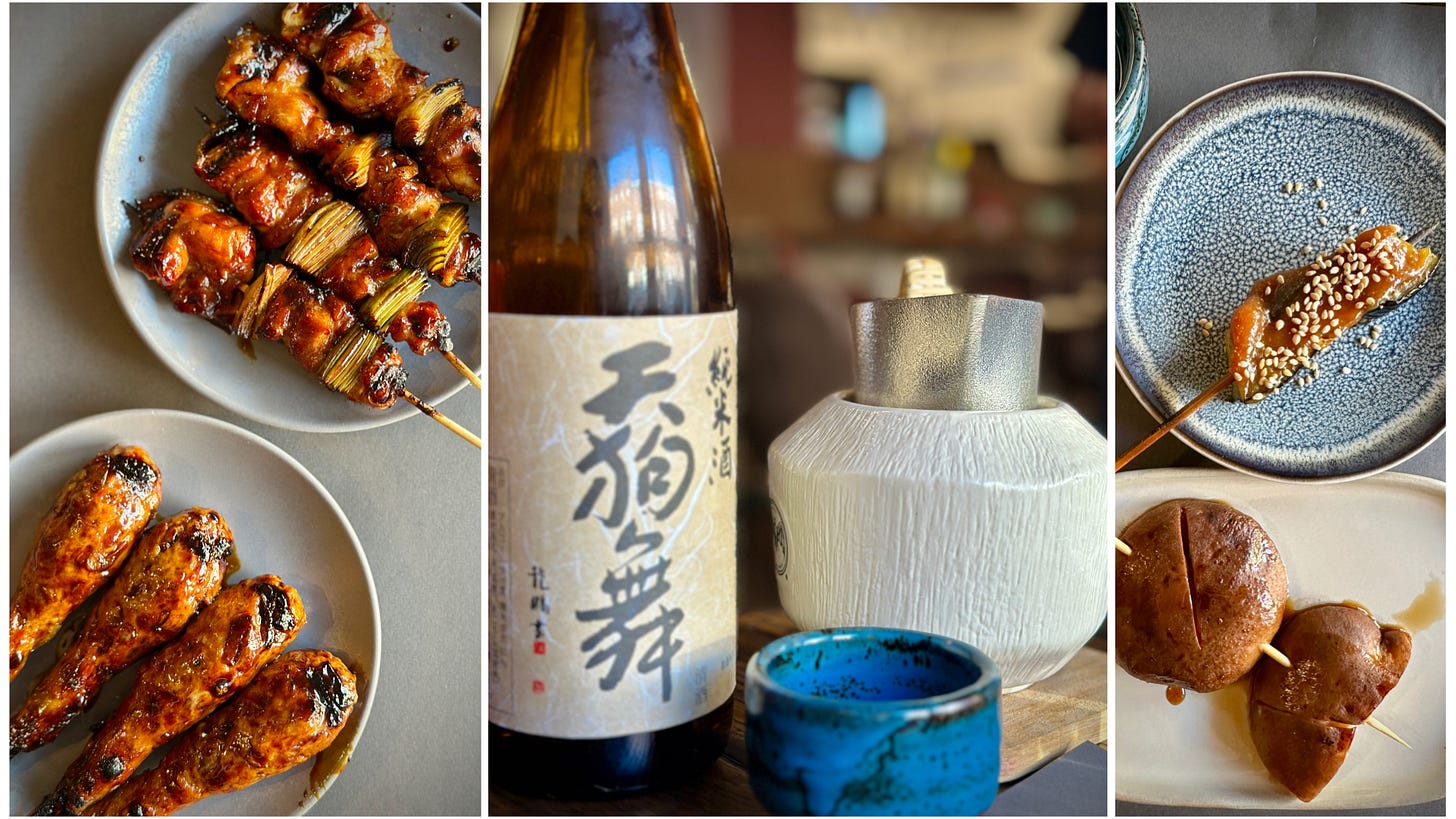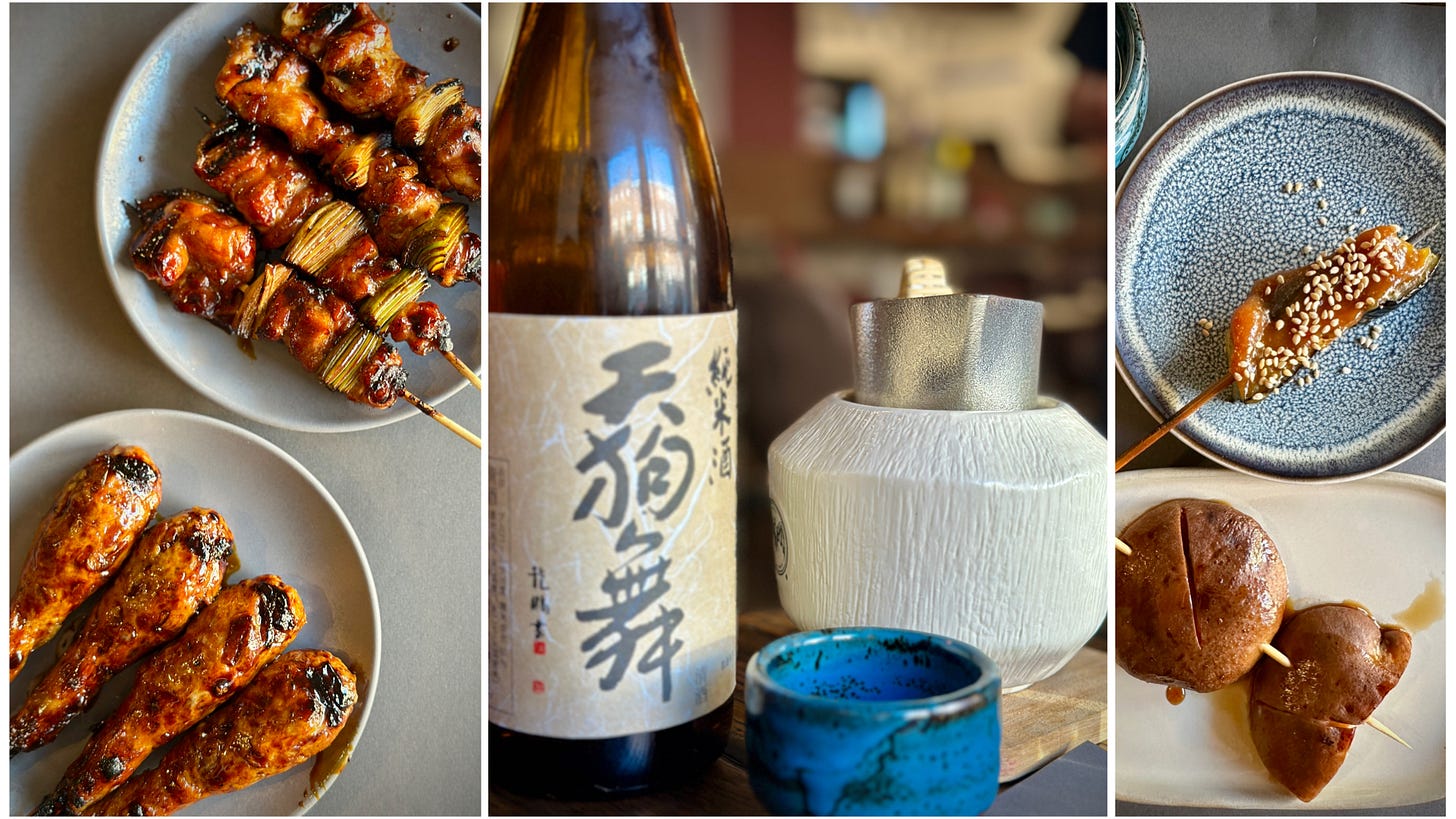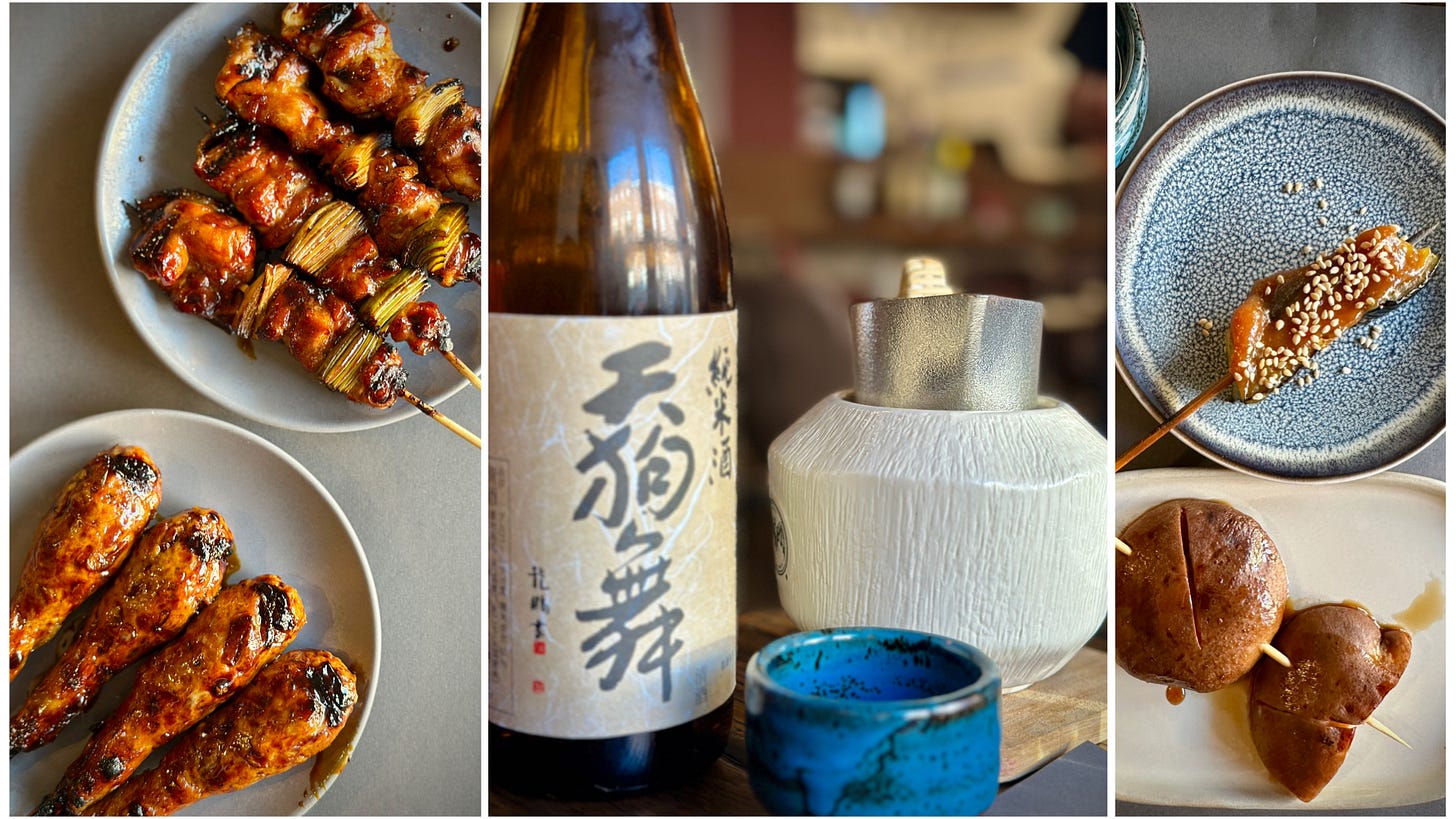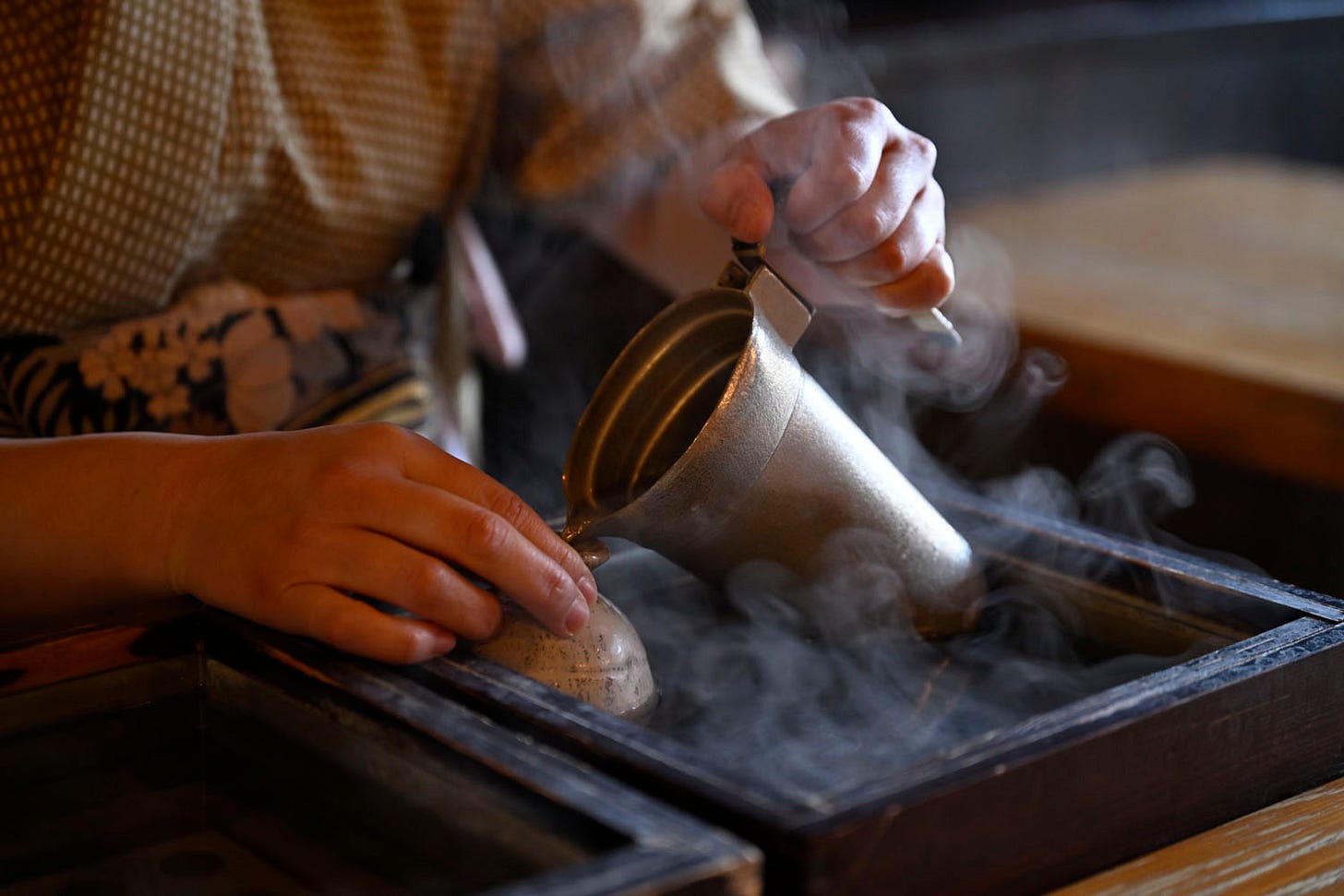Sake 101 #10: Understanding Kanzake (Warm Sake)
Think warm sake is only for cold nights? This post will change your mind—and your pairings.
📍Who This Is For
Curious about sake? No? Maybe you’ve only had cheap, low-quality versions—and gave up too soon. But choosing the right bottle, paired with the right dish, at the right moment can be unforgettable. Whether you work in wine retail or hospitality—or simply enjoy discovering standout bottles at home—this post is for you. Not in the trade? You'll still enjoy the journey (and perhaps discover a new favorite).
I'm Kazumi, a DipWSET wine and sake educator based in Amsterdam. With roots in Japanese and European food cultures, I write this Sake 101 series to bridge the gap, translating sake into the language of wine professionals. Each week, I explore one topic to demystify sake, deepen your understanding, and equip you with practical language for the floor or table.
This week's theme: Kanzake (Warm Sake) in Summer.
From Chilled to Charcoal: My Kanzake Revelation with Yakitori
It was a bright, sunny Sunday in June when we headed to La Kushi, a local restaurant in Amsterdam specializing in charcoal-grilled yakitori. For those unfamiliar, yakitori is a beloved Japanese dish of bite-sized chicken skewers—though it can also include vegetables or other meats—grilled over charcoal. Typically enjoyed at izakayas (Japanese tapas bar), food stalls, and yakitori-ya across Japan, it’s often paired with beer or sake.
Unlike dishes simmered in liquid, charcoal grilling intensifies umami, layering complexity with a smoky edge. Given the summer heat, I opted for a chilled sparkling sake while my husband chose beer. But neither quite hit the mark. We found ourselves craving something deeper.
Curiosity (and appetite) got the better of me. "Why not kanzake—even in summer?" I thought. And so, we ordered it. The moment the gently warmed sake arrived, I knew I'd made the right call. I was instantly 200% happier. The grilled chicken’s savory intensity met the sake’s depth in perfect harmony—an umami symphony. That evening shifted my perspective: kanzake isn’t just a winter indulgence. Especially in Europe, where summer evenings tend to be comfortably cooler.
Summer also brings bold flavors: barbecued meats, charred vegetables, anything touched by flame. Rich styles of sake like Yamahai or Junmai respond beautifully to these dishes, enhancing their umami in a way that chilled drinks rarely match. And there’s power in contrast too. Pouring a warm sake after a cold appetizer—perhaps citrusy zucchini carpaccio or lightly marinated seafood—creates a beautiful shift in texture and tone, much like moving from a crisp white wine to a mellow red.
There’s also a physical comfort to kanzake. Unlike cold beverages that numb the palate or chill the stomach, warm sake is kind. It encourages you to slow down, share food, talk late into the evening. It’s gentle on the body, and even better for the soul.
Temperature Matters: Kanzake(Warm Sake)
What makes warmed sake so irresistibly comforting? When gently heated, sake becomes softer, rounder, and more expressive. Sweetness, acidity, umami, and texture are all enhanced. Glutamic acid—at the heart of umami—comes to the forefront, deepening the savory character. Studies have shown that warming sake increases perceived umami, thanks to improved amino acid extraction and the greater volatility of aromatic compounds.
Temperature also plays a decisive role in shaping aroma. At lower warm ranges, fruity esters like apple, banana, and pear become more prominent. As the temperature rises, these lighter notes give way to richer, earthier tones—think almonds and mushrooms. At the same time, gentle warming softens sharp alcohol edges, leading to a smoother, more harmonious mouthfeel. Warming sake is also thought to evoke a Maillard-like effect, as amino acids and sugars gently interact under heat, deepening flavor and complexity.
I’ve always loved the poetic names assigned to sake temperature ranges in Japanese. Each stage unlocks a new expression of the same sake—like turning a kaleidoscope and discovering a different hue. Mastering temperature isn’t just a matter of technique—it’s a quiet art.
The Warming Spectrum of Kanzake
Sunlight Warm (30°C / 86°F) – Hinata-kan (日向燗)
Gently warmed, just above room temperature. Softens acidity and brings out a mellow texture.
Body Temperature (35°C / 95°F) – Hitohada-kan (人肌燗)
As warm as human skin. Balances sweetness and umami, with a gentle, silken mouthfeel.
Lukewarm (40°C / 104°F) – Nuru-kan (ぬる燗)
Mild warmth often considered the sweet spot for umami. Flavors broaden and textures smooth out.
Warm (45°C / 113°F) – Jo-kan (上燗)
A deeper, rounder mouthfeel emerges. A good match for richer dishes.
Hot (50°C / 122°F) – Atsu-kan (熱燗)
Bold and hearty. Umami becomes pronounced, perfect alongside robust, savory foods.
Very Hot (55°C+ / 131°F+) – Tobikiri-kan (飛切燗)
Intensely hot. Sharpens acidity, heightens aromas—demanding, but thrilling when done right.
Warming sake is a quiet ritual—an act of care as much as craft. Traditionally, sake is warmed by placing a ceramic tokkuri in a hot water bath, allowing the heat to gently draw out flavor and fragrance. Watching it warm in silence can feel meditative.
In restaurants and sake bars, you might encounter gleaming tin vessels. They conduct heat quickly and bring a silvery elegance to the table. And in modern venues, kanzake machines ensure precise temperature control, much like a wine cellar for sommeliers.
At home, though, I keep it simple. I pour sake into a ceramic cup and warm it gently in the microwave, checking the temperature every 10 seconds with my hand. It’s not ceremonial, and certainly not traditional—but it works. The trick is not to overdo it. Push the temperature too far, and the aromas vanish in a blink. But if you get it just right, and lift the cup to your lips as the steam curls upward—that’s when the magic begins.
Recommended Kanzake: Tengumai
Not all sake benefits equally from warming. Styles like Junmai, Yamahai, and Kimoto shine in this context, thanks to their vibrant acidity, pronounced umami, and fuller body. Sakes with maturity and depth are especially rewarding when gently heated—revealing hidden layers of aroma and complexity that often remain muted when served cold.
A standout example is Tengumai Junmai from Shata Shuzo, a historic brewery in Ishikawa Prefecture founded in 1823. With two centuries of brewing behind them, Shata Shuzo remains deeply rooted in tradition while continuing to refine their craft. Their signature style centers on Yamahai, a classic brewing method that underscores their commitment to bold, expressive sake.
Yamahai—short for yamaoroshi haishi—refers to a traditional fermentation starter that allows lactic acid to develop naturally, without additives. The method is slower and more unpredictable than modern techniques, but the payoff is significant: complex, full-bodied sake with deep umami and a wilder, more rustic character. Shata Shuzo is among the few producers who have mastered this technique with both consistency and elegance.
When gently warmed, Tengumai Junmai releases savory notes of toasted rice, dried mushrooms, and hazelnut, along with a faint lactic tang—a nod to its Yamahai roots. On the palate, it’s broad and savory, layered with hints of soy, caramelized onion, and grain. As the temperature rises, so does its depth. The finish is long and dry, with umami resonating softly and inviting yet another sip.
Its balance of acidity and umami makes it an ideal match for richly flavored dishes—like charcoal-grilled yakitori, the inspiration behind this week’s exploration.
Western Dishes That Love Kanzake
Warm sake isn’t just for traditional Japanese cuisine. Its layered umami, gentle acidity, and mellow warmth make it a surprisingly versatile partner for a wide range of Western dishes—especially those with roasted, creamy, or earthy elements. Think of it in the same family as an oxidative white or a soft, savory red wine.
Take creamy mushroom risotto: its earthy richness mirrors the deep, umami tones of warmed sake beautifully. Roast chicken with herbs—especially with a touch of soy or miso glaze—feels right at home alongside a Yamahai Junmai. Pan-seared pork with apple or mustard sauce pairs gracefully with sake’s subtle sweetness and acidity. A caramelized onion and cheese tart, with its golden depth, sings with the savory layers of Kanzake. And if you’re in the mood for comfort, a rich seafood chowder becomes unexpectedly refined when served with warm sake.
Let’s Trade Notes
Have you tried kanzake yet? Whether you work in wine retail, hospitality, or you’re simply curious to explore something new, I’d love to hear your experiences. Leave a comment or reply—I’m always keen to learn how warm sake lands on different palates.
This post is part of my Tuesday Sake 101 series, where I break down the fundamentals of sake through a wine-savvy lens. Starting next week, Sake 101 and my pairing content will come together in a single Friday edition—offering a deeper, weekly dive into the intersection of sake, wine, and Japanese or Asian food pairings.
If you found this useful, consider subscribing for weekly insights—so you can recommend sake with confidence at your shop, bar, or table.
Thanks for reading Pairing the World: Wine, Sake, and More! If you enjoy my work, you can support it by liking, commenting, stacking, or subscribing.
Sake 101: 夏に燗酒?そう思ったあなたにこそ読んでほしい
冬限定の飲み方だと思っていませんか?
📍この投稿の意図
オランダ・アムステルダム在住の日本酒とワインの講師、Kazumi(DipWSET)です。
この投稿は、海外のワインのプロフェッショナル——たとえば、ワインショップのスタッフ、ソムリエ、ワインエデュケーターといった方々に、日本酒の魅力をもっと知ってもらいたいという思いから英語で執筆しています。
日本とヨーロッパ、両方の食文化を背景に、
「日本酒やワインの魅力を自分の言葉で伝えられるようになりたい」
「日本と海外の架け橋になりたい」
そんな願いを込めています。
この日本語訳は、その取り組みを日本の皆さまに知っていただくために添えています。
今週のテーマは「夏の燗酒(Kanzake)」です。
冷酒から炭火へ──焼き鳥と燗酒の思いがけない出会い
6月のある日曜日、陽射しがまぶしい初夏の午後。私たちはアムステルダムにある「La Kushi」というレストランに向かった。炭火焼きの焼き鳥を専門にする、地元で人気の一軒だ。
「焼き鳥」と聞くと鶏肉の串焼きを思い浮かべるかもしれないが、日本ではそれだけにとどまらない。野菜やほかの肉類も串に打ち、炭火でじっくりと焼き上げる。居酒屋や屋台、そして焼き鳥専門店で気軽に楽しむ、日本人にとってはごくなじみ深い料理だ。そしてその傍らには、ビールや日本酒が並ぶのが定番である。
煮込み料理のように液体で加熱される料理とは異なり、炭火で焼いたものは旨みが凝縮し、そこに燻香のようなニュアンスが重なる。私がその日選んだのは、夏の暑さを受けて冷やしたスパークリング日本酒。夫はいつも通りビールを頼んだ。しかし、どちらもなんだか物足りない。炭火焼きの力強い味わいに対して、飲み物が浮いてしまっていたのだ。
そのとき、ふと好奇心(と食欲)が勝った。「夏でも、燗酒ってアリなんじゃない?」と。試してみたくなり、温めた日本酒を注文した。そして、湯気をまとった酒が届いた瞬間、自分の判断が間違っていなかったことを確信した。ひと口飲んだそのとき、幸福度は一気に200%アップ。香ばしく焼けた鶏肉のコクに、温められた酒の深みが重なり、完璧なハーモニーを奏でていた。まるで旨みの交響曲のような一皿と一杯。その夜を境に、私の中で「燗酒=冬の楽しみ」という固定観念は消えた。
特にここヨーロッパでは、夏の夜は意外と涼しい。そんな気候だからこそ、温かい酒が体にも心にもやさしくしみ込んでいく。
夏こそ濃厚な味わいの季節──燗酒が生きるシーンとは
夏というと、どうしても冷たい飲み物に手が伸びる。でも実は、夏だからこそ「燗酒」が映える料理もある。たとえば、炭火で焼いた肉、焦げ目のついた夏野菜、直火の風味をまとうあらゆる料理。火にあぶられた食材が持つ、強く深い旨みに対して、冷えた飲み物では力不足に感じることも少なくない。
こうしたシーンでこそ、山廃(やまはい)や純米といった濃厚なスタイルの日本酒が真価を発揮する。温めた酒がもたらす奥行きは、冷酒では得られない味覚の重なりを生む。旨み同士が呼応し合い、料理と酒が一体となって響き合う瞬間は、体験としても記憶に残る。
さらに注目したいのは“温度の対比”だ。たとえば、最初の前菜に冷たい料理——柑橘の効いたズッキーニのカルパッチョや、軽くマリネした魚介——を出したあとに、やさしく温めた燗酒を合わせる。すると、食事のトーンが自然に切り替わり、質感も香りも深みを増していく。それはちょうど、シャープな白ワインから穏やかな赤ワインへとグラスが移るときのような、静かで美しい変化だ。
そして何より、燗酒は身体にやさしい。冷たい飲み物が舌を麻痺させたり、胃を冷やしたりすることがあるのに対して、燗酒は穏やかに包み込んでくれる。ゆっくりと食べて、話して、時間を共有する空気を自然に生んでくれる。五感に寄り添い、心にも温もりをもたらす飲み物なのだ。
温度がすべてを変える──燗酒という表現の可能性
日本酒を温めると、なぜこんなにも心地よく感じるのだろう?
その答えは、温度によって引き出される味わいと香りの変化にある。穏やかに温められた酒は、まるく、やわらかく、より豊かに感じられる。甘み、酸味、旨み、そしてテクスチャー——すべてが丸みを帯び、広がりを見せるのだ。
その中でも、うま味の中心にあるのがグルタミン酸。燗をつけることで、このアミノ酸の存在感が際立ち、酒の持つだしのようなコクが一層深まる。いくつかの研究では、温めた日本酒のほうが冷やした状態よりも、うま味の知覚が明確になることが示されている。アミノ酸の抽出量が増え、香気成分の揮発性も高まることで、こうした変化が生まれるのだという。
温度はまた、香りの構造にも大きく関わる。ぬるめの燗では、リンゴ、バナナ、洋梨のような果実系エステルが前面に出るが、温度がさらに上がっていくにつれ、香りのトーンも変化する。軽やかな果実香が徐々に後退し、アーモンドやキノコのような土っぽく、温かみのある香りへと移ろっていく。そして同時に、アルコールの角が取れ、口当たりはよりなめらかで調和的に。
さらに、燗酒の味わいの深まりは、加熱によってアミノ酸と糖が静かに反応する、「メイラード反応」に似た現象にも関係していると考えられている。これにより、香味の層がぐっと厚みを増し、複雑性が生まれる。
そして私が特に好きなのが、日本語の詩的な温度表現の数々である。燗酒には、温度帯ごとに名前がついており、たとえば「人肌燗」や「ぬる燗」など、その呼び名からすでに感覚が立ち上がってくる。ひとつの酒でも、温度によってまるで万華鏡のように異なる表情を見せてくれる。それは技術というより、静かな芸であるように思う。
燗のスペクトル──温度が導く、酒のもうひとつの顔
日本酒における「燗」の世界は、ひとつの温度では語れない。温度帯によって香りや味わいの表情が劇的に変わるからだ。それぞれの温度には、まるで季語のように美しい名前がつけられており、その言葉ひとつひとつが、温度を超えて感覚を伝えてくれる。
日向燗(ひなたかん)|Sunlight Warm(30°C)
室温よりわずかに温かい程度。酸味がやわらぎ、舌触りは丸くなめらかになる。優しく酒を目覚めさせるような温度帯。
人肌燗(ひとはだかん)|Body Temperature(35°C)
人の肌と同じくらいのぬくもり。甘みと旨みのバランスが取れ、口当たりは絹のようにやわらかく、包み込むような印象に。
ぬる燗|Lukewarm(40°C)
多くの人が「燗酒といえばこの温度」と感じる、旨みの“ゴールデンゾーン”。味わいが丸くなり、香りとテクスチャーの幅がぐっと広がる。
上燗(じょうかん)|Warm(45°C)
さらに一段階深く。酒の輪郭がよりくっきりし、コクのある料理との相性がぐんと高まる。温めることで、酒の骨格が明確に見えてくる。
熱燗(あつかん)|Hot(50°C)
芯の強さと力強さが立ち上がる温度帯。旨みの主張がはっきりと感じられ、こってりとした料理や濃い味付けともよく合う。
飛切燗(とびきりかん)|Very Hot(55°C以上)
圧倒的な温度が酸を引き立て、香りは一気に高まる。飲み手を選ぶが、決まったときの感動は格別。まさに“飛び切り”の体験。
こうした温度の違いを表現できるのは、日本酒ならではの楽しみ方だ。ワインでは“室温”や“セラー温度”といった大まかな分類にとどまることが多いが、日本酒にはそれ以上の緻密さがある。たとえば、同じ純米酒でも「ぬる燗」と「上燗」ではまるで別の酒のように感じられる。これは、温度そのものがひとつの“表現手段”であることを意味している。
燗をつけるという、静かで繊細な所作
日本酒を温めるという行為は、単なる加熱ではない。それはむしろ、静かな儀式に近い。温度を通して、酒の輪郭を引き出し、香りを呼び覚ますための、丁寧で穏やかな所作である。
伝統的な方法では、陶製の徳利に酒を注ぎ、湯煎にかけてじっくり温めていく。急激に熱を加えるのではなく、ゆるやかに、対話するように酒を温めるこの方法は、見ているだけでもどこか瞑想的な時間をもたらしてくれる。湯気の立ち上る様子を見守りながら、香りがふわりと立ちのぼるのを待つひととき。その時間にすでに、味わいの一部が始まっている。
現代のレストランや日本酒バーでは、錫(すず)製の酒器が使われることも多い。錫は熱伝導率が高く、素早く酒を温めることができる上に、食卓に置いたときの銀色の光沢がどこか上品で、特別感を添えてくれる。また、最近では温度管理が可能な「燗酒マシン」も登場しており、ワインにおけるセラーのように、細やかな温度調整ができる設備として注目されている。
とはいえ、私自身が自宅で燗をつけるときはもっとシンプルだ。陶器のカップに日本酒を注ぎ、電子レンジで10秒ずつ、手で温度を確かめながら少しずつ加熱していく。決して伝統的とは言えないが、意外にもこれで十分おいしくなる。ポイントは「やりすぎない」こと。温めすぎてしまうと、せっかくの香りが一瞬で飛んでしまう。でも、ちょうどいい温度に仕上がったとき——上がる湯気をそっとたどりながら口をつけたその瞬間、そこには確かに、静かで確かな“魔法”がある。
今週のおすすめ:天狗舞 純米──燗でこそ輝く酒
すべての日本酒が燗に向いているわけではない。温めることで真価を発揮するスタイルというのが確かに存在する。なかでも、純米、山廃、生酛といった伝統的で骨格のある酒は、燗にすることでまるで別物のように香味が立ち上がる。
こうしたスタイルには、はっきりとした酸、力強い旨み、そしてややふくよかなボディが共通しており、温めることで、それぞれの持つ「隠れていた表情」が開いてくる。冷やして飲んだときには見えにくかった複雑さや奥行きが、燗によってふわりと立ちのぼり、静かに、しかし確実に伝わってくるようになる。
中でも特に印象的だったのが、石川県にある車多酒造の「天狗舞 純米」。この蔵は1823年創業、200年以上にわたり酒造りを続けている老舗であり、特に山廃仕込みの技術に定評がある。伝統を守りながらも、ひとつひとつの酒に磨きをかけ、現代の食卓にも馴染む味わいを追求している点において、まさに「今、伝えるべきクラシック」だと感じる。
山廃とは「山卸廃止酛」の略で、酒母において乳酸を人工的に加えず、自然の乳酸菌の力でじっくりと酸を生成させていく手法だ。その過程は時間もかかり、予測も難しい。しかし、その分だけ、出来上がる酒は骨格があり、旨みが濃く、どこか野趣を感じさせる深みがある。
天狗舞 純米をぬる燗にすると、香ばしい米の香り、干し椎茸やヘーゼルナッツのようなナッティな要素、そしてわずかに乳酸由来のニュアンスが立ち上がる。口に含むと味わいは広がり、醤油やカラメルオニオン、穀物を思わせるようなレイヤーが交互にあらわれる。温度が上がるにつれ、その複雑さと深さはさらに強まり、余韻は乾いたうま味とともに長く、静かに続いていく。
酸と旨みのバランスが非常によく、グリルした料理と合わせるには最適。とりわけ、炭火焼きの焼き鳥とは見事な相性を見せる。今週のテーマそのものとも言える、温めることで本領を発揮する一本だ。
洋食と燗酒の、思いがけない出会い
燗酒は和食だけのためのものではない。その重層的な旨み、やわらかな酸、そして穏やかな温もりは、実はさまざまな洋風料理とも驚くほどよく合う。とりわけ、ロースト、クリーミー、ナッティ、アーシーといった要素をもつ料理とは、見事なまでの相性を見せる。ワインにたとえるなら、酸化熟成型の白ワインや、やわらかくて旨みのある赤ワインに近いポジションだと捉えるとわかりやすいかもしれない。
たとえば、クリーミーなマッシュルームリゾット。きのこの土っぽい香りと、チーズやバターの濃厚なコク。ここにぬる燗の山廃純米を合わせると、旨みが層のように重なり、料理全体がひとつ上の次元へと引き上げられる。
あるいは、ハーブを効かせたローストチキン。もし、そこに味噌や醤油ベースのグレーズを塗っていれば、もうそれは燗酒の理想的なパートナーになり得る。温めた純米酒が、鶏肉の脂と香ばしさをやさしく受け止めながら、余韻に奥行きを与える。
さらに、リンゴやマスタードソースを添えたポークソテー。燗酒に含まれる自然な甘みと酸味が、果実味やスパイスのニュアンスと絶妙に呼応し、ワインではなかなか出せない一体感が生まれる。
玉ねぎのキャラメリゼとチーズのタルトは、まさに燗酒が好む「うま味と甘みと香ばしさ」の三重奏。ここでも山廃や熟成純米など、香味に厚みのあるタイプを選べば、香りの立体感が何層にも広がっていく。
そして、心からおすすめしたいのが、濃厚なシーフードチャウダー。牛乳やクリームをベースに、魚介のだしと旨みが溶け合うこの料理は、温かい日本酒と合わせることで驚くほど上品な一皿に変わる。燗酒が持つやわらかな酸とまろやかさが、スープの乳脂肪を包み込みながら、貝のミネラルや魚介のうま味を繊細に引き立ててくれる。
洋食と燗酒——この組み合わせを試していないのは、本当にもったいない。ワインでなければならない、という思い込みを一度外してみれば、新しいペアリングの可能性が、きっと広がってくる。
📌 話そう、燗酒のこと
夏に燗酒を試したことはありますか?
ワインショップやレストランの現場で働いている方も、あるいはただ「ちょっと面白そう」と思って読んでくださった方も、ぜひあなたの体験を教えてください。温めた日本酒をどんな料理と合わせたか、どんな風に感じたか——コメントや返信をいただけると、とても嬉しいです。
この投稿は、毎週火曜にお届けしている**「Sake 101」シリーズ**の一部です。日本酒の基礎を、ワインの知識に親しんだ方にも分かりやすく伝えることを目指しています。
そして、来週からはこの「Sake 101」と、これまで別々に展開していたペアリング投稿を金曜に統合します。これにより、週1回、より深く日本酒と料理、そしてワインとの交差点を掘り下げる形になります。日本やアジアの食文化とともに、味わいの裏にある科学や文化的背景にも触れていきます。
👉 この投稿が役に立ったと感じた方は、ぜひ購読をご検討ください。お店やバー、あるいはご自宅の食卓で、日本酒をもっと自信を持ってすすめられるようになるためのヒントを、毎週お届けします。
Pairing the World: Wine, Sake, and More を最後まで読んでいただき、ありがとうございました。もしこの試みに共感いただけたら、「いいね」「コメント」「スタック」「購読」で応援していただけると嬉しいです。
「日本酒やワインの魅力を、自分の言葉で伝えられるようになりたい、日本と海外の架け橋になりたい」そう考えて、英語で書いています。この取り組みが、日本酒に関わる方々にとって「応援したくなる活動」だと感じていただけたら幸いです。また、コラボレーションのアイデアをお持ちのインポーターや酒蔵の皆様、下記からご連絡をお待ちしております。








